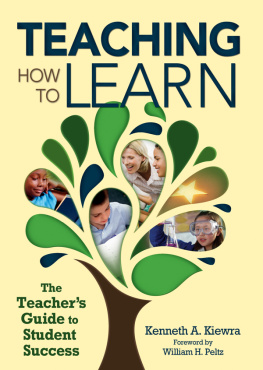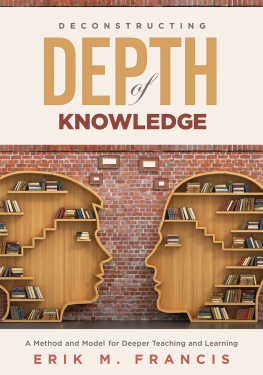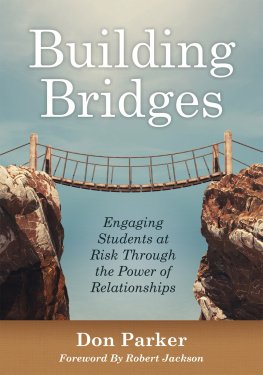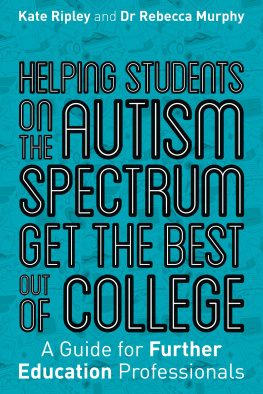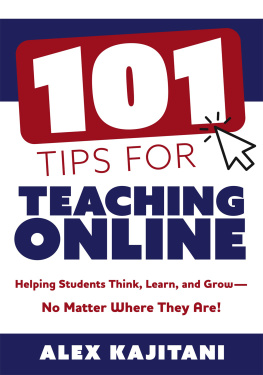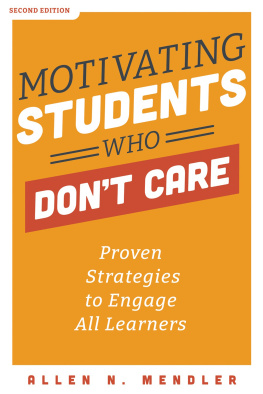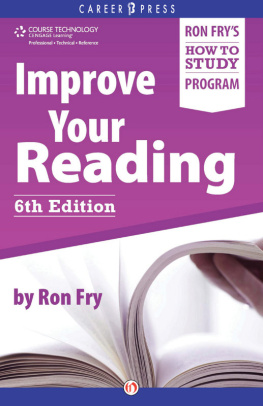Copyright 2009 by Corwin Press.
First Skyhorse Publishing edition 2016.
All rights reserved. No part of this book may be reproduced in any manner without the express written consent of the publisher, except in the case of brief excerpts in critical reviews or articles. All inquiries should be addressed to Skyhorse Publishing, 307 West 36th Street, 11th Floor, New York, NY 10018.
Skyhorse Publishing books may be purchased in bulk at special discounts for sales promotion, corporate gifts, fund-raising, or educational purposes. Special editions can also be created to specifications. For details, contact the Special Sales Department, Skyhorse Publishing, 307 West 36th Street, 11th Floor, New York, NY 10018 or .
Skyhorse and Skyhorse Publishing are registered trademarks of Skyhorse Publishing, Inc., a Delaware corporation.
Visit our website at www.skyhorsepublishing.com.
10 9 8 7 6 5 4 3 2 1
Library of Congress Cataloging-in-Publication Data is available on file.
Cover design by Rose Storey
Print ISBN: 978-1-63450-374-7
Ebook ISBN: 978-1-5107-0129-8
Printed in the United States of America
Contents
William H. Peltz
Foreword
William H. Peltz
W hen I grew up, teachers seemed to assume that students were born knowing how to study and behaved as if successful study behaviors were inheritable traits. Students who werent working up to their potential were treated as if their genes just needed to be activated. I remember teachers telling me I should work harder. I never knew what that trite phrase really meant, but I painted a grave expression on my face, nodded my head, and then walked out the classroom door, only to continue studying in my sloppy, ineffective ways. Some teachers told me that I was clearly an intelligent boy and capable of earning better grades, but they left it to me to divine how I might accomplish that elusive goal. I had some truly great teachers, but I cannot recall any of them ever giving me a single strategy that might have changed my behavior or improved my study techniques. For a long time, I was unfocused, unorganized, and often uninterested. Eventually, I stumbled on techniques that worked for me. When I became a teacher, I discovered my experience was not unique. Like me, few of my students had ever been taught how to study, and although they wanted to do well, many did not know how to approach their work. I quickly learned that to help my students master my discipline, I would also have to help them learn the requisite study techniques.
Teaching a subject, that is, packaging and dispensing the correct information, creating dynamic class activities, writing homework exercises, and designing tests and quizzes, is a comparatively easy task. What is more challenging is observing and diagnosing the learning characteristics of the students, engaging them in a truly motivating dialogue, and helping them develop the learning skills that will give them optimum success. Not many teachers retool their class presentations in order to introduce and reinforce learning strategies. Regardless how difficult it might be, I believe opening this particular door and helping students learn how to learn should be central to all teaching. Enabling students to become self-aware, independent learners should be a central component of every teachers professional mission statement.
For this reason, I am very excited by Kenneth Kiewras Teaching How to Learn. He is not intent on simply providing a few study tips and tricks. Instead, he gives his readers a well thought out progression of strategies that do nothing less than help all students SOAR to success, an acronym he created to help the reader remember the basic steps of his model. Dr. Kiewra has a wonderful and humane vision: to empower all students so that they become any time, any place learners. He does not just focus on the student, however. His goal is to help every teacher become optimally effective so that learning is maximized. He shows teachers how to design instructional techniques that work synergistically with the child who is learning how to learn.
I enjoyed reading Teaching How to Learn. It is filled with anecdotes that engage the reader. Dr. Kiewra includes just enough research to make his points, but not so much that the book risks being dry and uninteresting. His sense of humor and light, engaging style made me feel I was sitting down with a colleague and friend, having a professional conversation in which I was the beneficiary. Dr. Kiewra knows how kids learn and what the teacher can do to help them learn more effectively, and he shares his expertise with a passion for teaching and an obvious compassion for the children who study in our schools. He offers multiple examples of the strategies that he describes so that we teachers can help our students grow into empowered, confident learners. This book is both insightful and helpful.
Teaching How to Learn starts with a bold statement. It claims that our schools fail because they focus too narrowly on course content and skills. By neglecting to teach students how to learn, schools deny most students the opportunity to achieve their maximum potential. Dr. Kiewra makes it quite clear that study skill teaching is not to be confused with remediation and that these skills are not something that students learn naturally as they move up in grade levels. He understands that many teachers do not create an ideal learning environment simply because they themselves were not taught how to learn. He deserves much praise, therefore, because he shares the techniques that can rectify this problem. His goal is to improve instruction so that students can soar, and I believe he succeeds magnificently. Professor Kiewra offers a carefully laid out model, and now it is up to us teachers to implement it.
This book should be read by anyone who wants to grow as an educator and who strives to become a master teacher. It should be required reading for the teacher who cares deeply for the total growth, success, and happiness of every child in the classroom. Teaching How to Learn should occupy a place in the professional library of every teacher, new or seasoned veteran, and should be found in every faculty lounge. I hope you enjoy it!
Preface
S uppose you were to teach students the following information about the appearance of spiders and insects. How would you go about it?
Spiders have two body parts: the head and chest. They have eight legs and eight eyes. They do not have wings or antennae. Their skeleton is a hard outer shell that protects them.
A hard outer shell protects an insects three body parts: head, chest, and abdomen. They usually have two big eyes and three smaller eyes between them. Six legs and one or two pairs of wings propel insects. Insects also have a pair of antennae for sensing things.
Simply giving students these blocks of information to learn is not the ticket. Most students employ weak learning strategies. Teachers can foster learning by helping students select, organize, associate , and regulate lesson information. When teachers do, they help students SOAR to success. Moreover, teachers can teach students SOAR strategies so they can learn effectively anytime, anyplace. Lets take a look.
Select
Spiders
Body Parts: 2, Head and chest
Legs: 8
Eyes: 8
Wings: None
Antennae: None
Skeleton: Hard outer shell
Insects
Skeleton: Hard outer shell
Body Parts: 3, Head, chest, and abdomen

